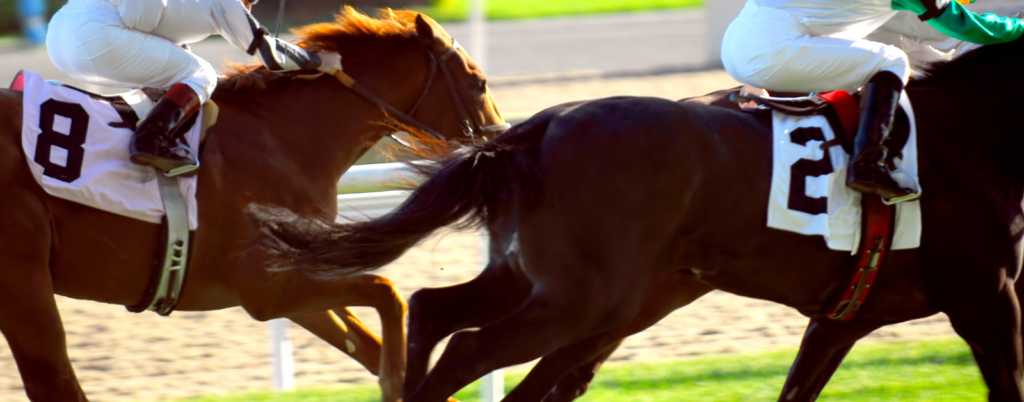There’s something undeniably thrilling about watching magnificent horses thunder down the track, their jockeys urging them towards the finish line. But for many racing enthusiasts, the excitement doesn’t stop there. Handicapping adds an intellectual challenge to the spectacle – the quest to decipher clues, analyze data, and outsmart the crowd by predicting the winner.
Handicapping is a blend of art and science. You’ll pore over past performances, dissect speed figures, and consider factors like track conditions and jockey experience. It’s about identifying the horses with the best combination of talent, form, and racing luck to cross the finish line first. Handicapping isn’t just about winning bets (although that’s a perk!). It’s about deepening your understanding of the sport and appreciating the nuances that separate the contenders from the champions. If you’re ready to elevate your race day experience from casual spectator to invested strategist, this guide will lay the foundation for your handicapping journey.

What Exactly is Handicapping?
Imagine horse racing as a complex puzzle with many interlocking pieces. Handicapping involves meticulously examining each piece—the horses, their past performances, the jockeys, the track conditions, and more—and assembling them to reveal the bigger picture. Your goal as a handicapper is to determine which horses have the highest probability of winning and, crucially, to identify whether their odds offer value compared to your assessment of their chances.
Think of it like this: A horse might have fantastic speed figures, but if it’s never won on a wet track and today’s forecast calls for rain, those figures become less important. Or, a jockey might have an excellent track record, but if they’ve never ridden a particular horse before, that adds an element of uncertainty. Handicapping is about weighing all these factors, identifying potential upsets, and finding hidden value in the betting market.
The thrill of handicapping lies in the intellectual challenge. It’s a testament to the complexity of horse racing that there’s no single formula for success. Handicapping rewards those who dedicate time and effort to studying the sport and the satisfaction of picking a winner – especially a long shot! – Based on your analysis, it is unmatched.
Here are some examples of how to handicap a bet:
Example 1: The Classy Contender
- Scenario: A lightly raced 4-year-old previously campaigned in Europe with decent results is now making its US debut in a mid-level allowance race.
- Handicapping Approach:
- Analyze European form: Pay close attention to the tracks the horse raced on (turf vs. dirt surfaces), distances, and the quality of competition faced.
- Consider training change: Research the horse’s new US-based trainer. Have they had success with horses transitioning from overseas?
- Assess the competition: Are the other horses in the race proven at this distance and class level?
- Look for value: European horses are sometimes overlooked by bettors in the US. If your analysis suggests the horse is competitive, its odds might be better than they should be.
Example 2: The Track Specialist
- Scenario: A veteran horse with a mediocre overall record suddenly shows a string of improved performances at a specific track.
- Handicapping Approach:
- Dig into past performances: Look specifically at the horse’s races at this particular track. Are there consistent patterns regarding running style, distance, or surface preferences that align with today’s race?
- Consider jockey/trainer factors: Is there a jockey who seems to get the best out of this horse, especially at this track? Or has a recent trainer change sparked the horse’s improvement?
- Look for hidden favorites: Sometimes, horses that thrive at a specific track go unnoticed by casual bettors.
Example 3: Weathering the Storm
- Scenario: Heavy rain threatens a major race day, likely turning a fast dirt track into a muddy mess.
- Handicapping Approach
- Identify mudders: Some horses excel in muddy conditions. Check their past performances for wins or strong finishes on tracks labeled “sloppy” or “wet.”
- Adjust speed expectations: Muddy tracks often favor horses who race close to the pace, as it’s harder to make up ground from the back of the pack.
- Be wary of favorites: Front-running horses who depend on a dry, fast track may be overvalued by the betting public if the weather takes a turn.

The Building Blocks of Handicapping for Beginners
Past Performance
A horse’s race history is like its resume. Don’t just glance at the wins—look at the whole picture. A close second-place finish against top-tier competition might be more impressive than a win against a weak field. Pay attention to trends: Is the horse getting faster and finishing closer to the lead in recent races, or are they starting to struggle?
Example: You see a horse that’s never won a race. But, upon closer inspection, its last three races were against much tougher competition than today’s field. If the horse finished close in those races, it could be primed for a win today at a lower-class level.
Speed Figures
Speed figures translate a horse’s raw time in a race into a standardized number. This helps you compare horses who raced on different days or tracks. Look for consistent improvement in speed figures over a horse’s recent races – this is a vital sign that the horse is getting fitter and faster, even if it hasn’t won yet.
Example: Two horses both won their most recent race. Horse A won in a slightly slower time, but the track was known to be very slow that day. Horse B’s track was faster. If Horse A has a higher speed figure than Horse B after adjustments, it means Horse A may have run the more impressive race.
Jockey and Trainer
Jockeys and trainers have a significant impact on a horse’s performance. A skilled jockey can make tactical decisions that win races, while a top trainer can bring a horse to the track in peak condition. Research track records and statistics. Some trainers excel with longshots, while others are known for having their horses ready to win the first time out after a layoff.
Example: A horse is switching to a new jockey with a 25% win rate at the current race meet. That jockey might provide an edge, especially if the horse’s previous jockey struggled to get good results.
Track Conditions
Horses often have strong preferences for specific conditions. Blazing-fast sprinters might excel at short distances on dirt, while stamina-laden runners might thrive on longer turf races. Always factor in how the horse has handled similar track conditions.
Example: A horse has won multiple times on turf but has never finished in the top three on dirt. Those past turf performances lose some relevance if today’s race is on dirt.
Class Level
Horses race at different levels based on their ability. It’s a big challenge for a horse to jump up in class and win suddenly. Conversely, if a horse drops in class after struggling against tougher competition, it might have a significant advantage.
Example: A horse has struggled against Grade 1 competition (the top level). Today, it’s racing in a much easier Grade 3 race. This class drop could be a sign the horse is primed to break its losing streak.
Post Position
The position a horse starts in from the gate matters! Inside posts can be great for speedy horses in short races, as they have a shorter distance to the first turn. An outside post may give a horse more options to avoid traffic trouble in longer races.
Example: A horse with a come-from-behind running style starts from post position 1 (the inside) in a mile-and-a-half race. This could be a disadvantage, as the horse might get trapped behind slower horses early on.
Critical Points for Each Area:
- Past Performance: Look for consistency and trends and consider the quality of the competition.
- Speed Figures: Focus on improvement patterns and compare horses relatively using the adjusted figures.
- Jockey and Trainer: Research win percentages, track records, and successful pairings.
- Track Conditions: Prioritize past performances that closely match today’s race conditions.
- Class Level: Be wary of horses moving up in class, and look for class drops as a potential sign of value.
- Post Position: Consider the horse’s running style and race distance when assessing its starting position.

Handicapping as a Skill: Strategies for Success
While there’s no single path to becoming a master handicapper, here are some key strategies to develop your skills and find your winning approach:
- Start with the Basics: Don’t get overwhelmed by the information available. Focus on the core concepts we’ve discussed – past performances, speed figures, class, and track conditions.
- Develop a System: Create a checklist or method for analyzing each race. This will keep you focused and help you avoid overlooking crucial factors. For instance, your system might involve always looking at a horse’s speed figures first, then past performances, and finally, its jockey/trainer pairing.
- Specialize (at least initially): You might find more success by initially focusing on specific types of races. For example, turf sprints often favor different kinds of horses than long-distance dirt races. Get comfortable handicapping one type of race before branching out.
- Track Your Bets: Keep records even if you’re betting small amounts (or just on paper!). Analyze both your winning and losing bets to identify patterns. Do you tend to overestimate favorites? Do you spot value in horses dropping in class?
- Embrace Learning: The world of horse racing is constantly evolving. Read handicapping blogs, listen to podcasts, and explore different handicapping tools to expand your knowledge.
Your Handicapping Game Plan
Here’s a simple plan to apply your developing handicapping skills:
- The Pre-Race Ritual:
- Gather Resources: Choose your preferred sources for race programs, past performances, and any speed figure/ handicapping tools you use.
- Select a Race: Start with a race that fits your specialization (if you have one).
- Work Your System: Analyze each horse according to your method, taking notes as you go.
- Compare to the Odds:
- Identify Value: Based on your analysis, are there horses whose odds seem too long? These might be potential value bets.
- Spot Overlays: Are there horses that seem overbet by the public? These might create opportunities to bet against the favorite.
- Bet Strategically:
- Manage Your Bankroll: Never bet more than you can afford to lose. Start with small bets as you build confidence.
- Consider Different Bet Types: If your handicapping pinpoints the top finishers, explore exotic bets (exactas, trifectas) for potentially higher payouts.
Example: Putting it into Practice
Let’s say you’re focusing on turf sprints. You find a race with a mix of experienced horses and a few newcomers. Your handicapping process might involve:
- We are prioritizing past performances on turf at a similar distance.
- I am checking speed figures to see who has displayed the rawest speed.
- Noting any trainer changes or jockey switches, as these can sometimes signal improved performance.

A Brief Introduction to Advanced Handicapping
Mastering the fundamentals of past performance, speed figures, and track conditions lays a strong foundation. But to elevate your handicapping game, it’s time to delve into more nuanced factors.
By considering these advanced elements alongside the basics, you’ll gain a deeper understanding of each horse’s potential and uncover hidden value often overlooked by the casual bettor. Here are some examples of advanced betting strategies that will later be discussed.
Absolutely! Here’s an expanded table with 15 advanced handicapping factors, including the additional ones you requested.
| Factor | Explanation | Why It Matters |
|---|---|---|
| Running Style | Horses prefer to run at the front (front-runners), from behind (closers), or in mid-pack (stalkers). | Predicts how they’ll handle the race pace and jockey tactics. |
| Track Bias | Some tracks favor certain running styles or post positions (ex: inside posts for speed horses). | Identifies horses advantaged or disadvantaged by the track conditions. |
| Post Position Draw | Starting position impacts how a horse can execute its running style. | Assess the post’s impact based on the horse’s running style and track bias. |
| Layoffs and Recent Form | Horses returning from breaks or in top form are key factors. | Recent races offer insights into fitness, improvement, or decline. |
| Equipment Changes | Blinkers, shoes, etc., can alter a horse’s running style or focus. | Gauge how changes may benefit or hinder the horse based on past use. |
| Weather Conditions | Rain, heat, etc., impact track speed and horse stamina. | Understand how the weather might create favorable or unfavorable conditions for specific horses. |
| Equine Bloodlines | Sire (father) and dam (mother) lines pass on traits like speed or endurance potential. | Pedigree offers clues about a horse’s inherent abilities and distance preferences. |
| Mating History | Analyzing the success of a sire/dam pairing in producing winners provides more pedigree insights. | Helps identify horses with favorable genetic predispositions. |
| Nutrition | A balanced diet is crucial for energy and performance. | While specifics may be unavailable, consider the trainer’s reputation for conditioning. |
| Horse Ownership | Ownership styles influence racing decisions and the level of competition a horse faces. | Indicates potential for targeting high-profile races or finding value with lesser-known contenders. |
| Jockey | A skilled jockey can bring out the best in a horse or make poor tactical decisions. | Research jockey win rates, track records, and success with specific horse types. |
| Trainer | Trainers have different strengths in preparing horses for certain distances or track conditions. | Analyze a trainer’s record to see if their style aligns with the demands of the race. |
| Workout Reports | Pre-race workouts indicate fitness and readiness. | Look for consistently fast workouts or signs of a horse rounding into form. |
| Physical Conformation | A horse’s build can impact its stride and efficiency. | While difficult to assess without seeing the horse live, look for mentions of a horse having good conformation in race commentary. |
| Medication Changes | Some medications can impact performance. | Note medication changes (Lasix, Bute, etc.) and their potential effects. |
Important Note: Accessing some of this information might require specialized resources or subscriptions to pedigree services. For the most comprehensive analysis, consider these advanced factors and the core principles of handicapping.
Conclusion: Empowering Your Handicapping Journey
Handicapping is a skill that takes time and Practice to master. Thankfully, a wealth of resources are available to support you. From detailed race data to expert analysis, these tools will help refine your strategies, uncover hidden value, and make more informed betting decisions.
Resources to Get You Started
- Race Programs and Past Performances
- Equibase: https://www.equibase.com/
- Daily Racing Form: https://www.drf.com/
- Brisnet: https://www.brisnet.com/
- Speed Figures
- Beyer Speed Figures (available through Daily Racing Form)
- Thoro-Graph Speed Figures: https://www.thorograph.com/
- Handicapping Tips, Analysis, and News
- Horse Racing Nation: https://www.horseracingnation.com/
- TimeformUS: https://www.timeformus.com/
- America’s Best Racing: https://www.americasbestracing.net/
- And of course, be sure to explore our own website’s resources!
Important Note: Always remember to gamble responsibly. Use these resources to enhance your enjoyment of horse racing, and never bet more than you can afford to lose.




Leave a Reply